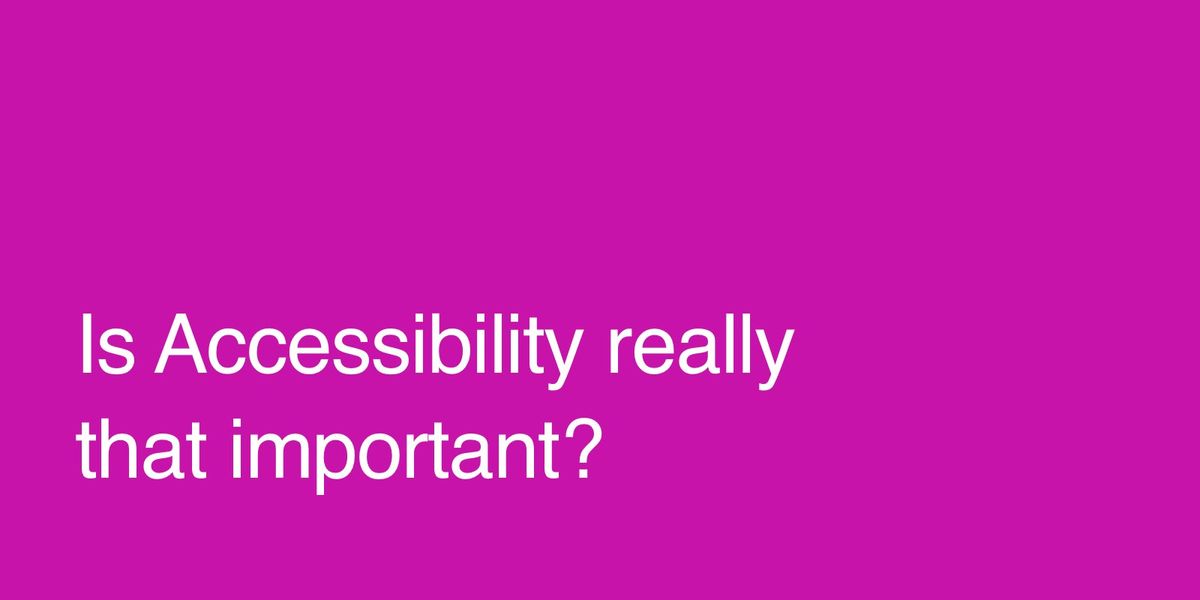Is Accessibility really that important?

This question of whether Accessibility is really that important is no doubt one you’ve either had yourself or heard someone else say. It may be the kind of question that drives you crazy as you’ve been battling to get your stakeholders to care about accessibility and the importance of considering the needs of those users.
It’s Global Accessibility Awareness Day today and for organisations who are still battling to get UX, and particularly User Research, into their process, starting another battle for Accessibility can feel like something that needs to be sidelined. Often, Accessibility practices get cut from projects due to either product teams not understanding the issues or budget concerns. However, you may be surprised at just how much Accessibility and good UX/Usability have in common and the amount of people who have Accessibility needs.
19% of adults are disabled
You can reasonably assume that around 20% of your users have Accessibility needs (the exact UK figure is 19% source). How old are your users? If they’re children this lowers to 8% but if they are older (pension age), this figure rises to 45%. So, how much Accessibility affects your users will somewhat depend on who those users are, but I’m sure you’ve been surprised by how large that percentage is. Most people think the figure is less than 5%.
You are also impaired (some of the time)
About one third of the population are temporarily impaired due to illness, injury or circumstance. On any day, that could include you, your family, friends, colleagues…
“When UX doesn’t consider ALL users, shouldn’t it be known as “SOME User Experience” or… SUX?” Billy Gregory, Senior Accessibility Engineer
Don Norman “What I see today horrifies me”
Did you know that the grandfather of UX, legend Don Norman, is now 83? With decreased eyesight and physical capabilities, he’s now experiencing the world as a user with Accessibility needs.
“The number of active, healthy oldsters is large and increasing. We are not a niche market. And businesses should take note: We are good customers often with more free time and discretionary income than younger people.
Despite our increasing numbers the world seems to be designed against the elderly. Everyday household goods require knives and pliers to open. Containers with screw tops require more strength than my wife or I can muster. Companies insist on printing critical instructions in tiny fonts with very low contrast. Labels cannot be read without flashlights and magnifying lenses. And when companies do design things specifically for the elderly, they tend to be ugly devices that shout out to the world “I’m old and can’t function!” We can do better.”
Accessible users can be very profitable…
7 out of 10 websites are not Accessible. Some figures indicate that it’s even more than this. This means there is a huge opportunity for you to capture this audience within your market. They also make for a very loyal customer. Check out this user quote:
“If I find a site I can use then I use it as much as possible; often even if I know I might be able to get things cheaper elsewhere. For example, I find it easier to have my supermarket shopping delivered and the best site I found to use is Ocado, so I use it. I know some things would be cheaper elsewhere but, well, the accessibility of the site and the app make it so easy why would I bother to look elsewhere when my experience tells me I’m likely to find problems.”
Top 5 things that exclude users
David Benyon author of Designing Interactive Systems, gives 5 reasons products often exclude users:
- Physical – it requires too much effort or physical strength to use.
- Conceptual – it is difficult to understand how to use it.
- Economic – it is too expensive.
- Cultural – users can’t understand metaphors regarding product interaction.
- Social – on joining a group, users don’t understand the group’s social conventions.
You’re biased because you’re young
Most people working in digital, design and UX are young. There aren’t many of us who are pension age. And this creates a further problem in that we naturally assume that everyone experiences the world as we do.
In psychology, this is called the false-consensus effect or false-consensus bias. It’s a type of cognitive bias whereby people tend to overestimate the extent to which their opinions, beliefs, preferences, values, and habits are normal and typical of those of others.
Sound familiar? How many of us have been in meetings and heard ‘I would do this’ ‘I think…’ And there’s an assumption that because that person thinks or feels that way, that your users will too. After all we’re all humans right? We must all think and use things the same way. Nope! I’m afraid it’s not that simple or there wouldn’t be a need for UX specialists in the world.
Use user research to make a difference
You need to ingrain an understanding of and empathy towards users and their behaviour within your organisation to get around this bias.
Often the quickest and easiest way to do this is to commission user research from an external agency. This is because, unfortunately, outside agencies are often taken more seriously (and viewed as experts) than internal employees (we know – we used to be internal employees). They also have all the tools and methods to turn things around quickly and easily.
If you are in the fortunate position to work for a company whereby you’re fully supported in conducting user research, then you’ll need to think about how you go about research with people who have Accessibility needs. The ideal way to go about this is ethnographic (at-home) research. You’ll be able to see the setup they use, both hardware and software and the settings they have in-place. You can also use a lab but you may not be able to accurately reflect the real world setup so the lab may be more suited for mobile and tablet testing, where the user can bring in their own device.
You’re breaking the law if you ignore Accessibility
According to the Equality Act (2010), Section 29(1):
“A person … concerned with the provision of a service to the public or a section of the public (for payment or not) must not discriminate against a person requiring the service by not providing the person with the service.”
Therefore not providing a service to a disabled person that is normally provided to other people is unlawful discrimination. This applies as much online as it does offline, whether you’re a business or a government site, so having an inaccessible site is actually breaking the law.
Inclusive design helps everyone
A great way to think about Accessibility is to view it as Inclusive design. Design that helps everyone.
Kat Holmes points out in her book Mismatch, that all of us have Accessibility needs. We all experience situational and temporary problems. “When outside in the sun, the text message that just arrived is unreadable: wouldn’t it be nice if the display, whether cellphone, watch, or tablet, could switch to large, higher contrast lettering? Are elderly people handicapped? Maybe, but so is a young, athletic parent while carrying a baby on one arm and a bag of groceries in the other (and perhaps trying to open their car door). Almost anything that will help the elderly population will end up helping everyone.”
Challenge yourself!
As part of World Accessibility Awareness Day, the team have a number of challenges for you to try so that you can feel what it’s like to use things from the perspective of someone with Accessibility needs:
- Go Mouseless For An Hour
- Enlarge Your Fonts
- Check for Sufficient Color Contrast
- Check Order of Elements
- Surf The Web With A Screen Reader For An Hour
Sources to improve Accessibility
There are lots of guidelines on the internet for how to begin improving Accessibility through design. There are some good tips on interaction-design.org and BBC GEL. You will also find some top tips from experts at our recent Accessibility and Design event:
Accessibility and Design: UX Crunch Manchester – Top tips from the BBC, Anaplan and AbilityNet
One day you will have Accessibility needs. Whether they are physical, cognitive or both. There is no denying the ageing process! Design with empathy for those who experience these issues every day right now and design for your future self.
Other articles you will like:
Share this post:


